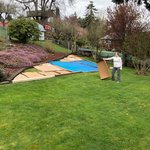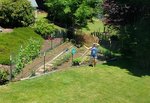

Although lawns are a key staple of many yards, not everyone knows that 30% to 60% of urban fresh water is used to keep it hydrated.
Janis McBride, a WSU Clark County Extension Master Gardener, said replacing sections of a lawn with plants that retain water more evenly can help curb high water usage. The tactic, known as lawn reduction, comes with other benefits as well, McBride said.
“Lawn reduction would be replacing a portion of the lawn with either plants or mulch that tends to be lower maintenance,” McBride said. “Historically, lawns originated as pastures, but they eventually came through aristocrats, because a lawn meant that you could afford to waste your land.”
She said that nowadays, wasting land is “something that is not conducive to nature.” She noted lawns are the number one irrigated crop in the United States, as they get three times more water than corn.
“There is now a movement toward getting away from that ‘perfect lawn’ that was so important in the post-World War II era of suburbs,” McBride said. “Suburbs went out so quickly, and it was very easy for a developer to just throw down some seed and they were done with the front yard.”
She said the advantages of lawn reduction include lower pesticide use, less maintenance, and less water usage. McBride can attest to the benefits since she has utilized the method on her own property for the past four years.
“I replaced a portion of my lawn with a vegetable garden,” she said. “It was an odd section that was difficult to mow, and it didn’t grow very well because it was on a bit of a slope and it wasn’t terraced. So I took that out by a lawn removal method … and then I terraced it and I now have tomatoes, peppers and my annual vegetable garden that grows there now.”
McBride noted some fellow Master Gardeners have chosen to replace their lawns with perennial shrubs, which she considers easy to maintain.
While McBride’s vegetable garden requires a lot of maintenance, she said others who are looking for a less burdensome route can plant trees and shrubs instead.
Other ideas include utilizing a bench, gazebo, or pergola to reduce the lawn further, which can create a “very usable” area in a yard, she said.
Besides replacing grass with plants, McBride said people can also cut their lawns down to 3 or 4 inches, as opposed to the usual 1 to 2 inches.
“What this does is you have a little meadow growing on your lawn, with lots of little flowers. It’s great for pollinators,” McBride said. “It’s actually still usable as far as traffic, so you can have pets out there and kids. … Even during the summer months, it’ll go through and remain somewhat green.”
Even if the lawn starts to turn a little brown, longer grass only requires 2 inches of water per month versus a shorter lawn, which generally requires more, she said.
Besides benefitting pollinators, she said lawn reduction can also provide habitat for various animals and creates a diverse plant palette that reduces runoff, which then protects the environment beyond a person’s property.